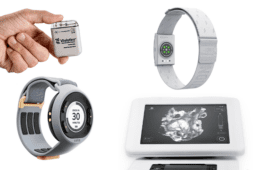The demands of the medical device marketplace require companies to deliver products to market faster while reducing expenses. This article discusses cellular manufacturing, one technique that helps orthopedic device manufacturers ensure high quality and increased profits while reducing waste and manufacturing time.
By Tom Barrett
AT A GLANCE
- Increased flexibility
- Reduced lead time
- Production of high product mix
- Reduced operating costs
- Increased work-force utilization
- Reduced manufacturing space needs
 Trained operators program machining centers to create orthopedic implants that accommodate various patient profiles such as height, weight, and load-bearing ability. |
Orthopedic device manufacturers are under intense pressures to reduce costs while accelerating time to market. Additionally, the nature of the orthopedic business requires a large number of smaller volume components, as devices must be matched to a wide variety of patient needs. How can orthopedic device manufacturers hasten time to market and reduce costs with low volumes of numerous components?
One method is through cellular manufacturing, which enhances the flexibility to produce an increasingly high mix of products. It allows smaller quantities of components to be manufactured while simultaneously reducing costs, improving quality, reducing lead times, and ultimately, increasing flexibility.
Combined with lean manufacturing principles, companies have implemented cellular manufacturing to streamline processes and reduce the time to market in response to customer demand and an increasingly competitive global market.
A Factory Within a Factory
Cellular manufacturing can be considered a factory within a factory. It features “cells” that contain a group of dedicated equipment, machines, or workstations located in close proximity and based on similar products or processes. The cell is configured for speed, with products manufactured by cross-trained personnel and predisposed to work as a unit or team.  The use of state-of-the-art CNC machining centers in a cellular manufacturing environment greatly reduced cycle times and manufacturing costs in the production of an orthopedic implantable device. |
One of the key features of cellular manufacturing is the flexibility to quickly accommodate changes in the manufacturing demand. It is not uncommon in the orthopedic industry for an implantable device family to have hundreds of part numbers associated with it to accommodate varying patient profiles such as height and weight. Stocking these parts in quantity can result in very high inventory carrying costs.
The cost of manufacturing too much of the wrong product is a harsh reality impacting bottom line performance. An equally hard lesson, however, is having too few parts to satisfy a market requirement. In a competitive arena, doctors can and will go to alternative sources for medical devices.
With cellular manufacturing, companies can increase flexibility to accommodate the large number of component parts. The goal is to optimize workflow so as to dramatically reduce lead-time. With shortened lead times, manufacturers can quickly respond to customer requirements and produce the parts needed, as well as manage their inventory more effectively.
A cellular manufacturing process can have cycle times of days rather than the weeks necessary for the traditional batch process. In an industry of tight cost controls on medical devices, these shorter cycle times translate to reduced costs and accelerated time to market.
Reducing Cycle Time
Cellular manufacturing principles were recently applied in the production of a component for a prosthetic joint with more than 300 part numbers that required flexible production to meet customer demands. The prosthetic joint system component had previously been manufactured in a batch environment.A team of engineers, including experts in manufacturing, six sigma, and lean manufacturing methods, first evaluated various state-of-the-art equipment to manufacture this component. A dedicated manufacturing cell was created incorporating new CNC machining centers. The goal was to complete the production of the part, from raw material through manufacturing and inspection, in one cell. In addition, lean manufacturing methods and six-sigma principles were incorporated to optimize the processes required and to eliminate waste.
 Combining lean manufacturing principles with six-sigma quality creates powerful systems to eliminate waste and better manage work flows leading to increased speed to market and enhanced quality. |
Cycle time was further reduced in the various machining steps. Quality control was incorporated into the process itself rather than only at the end of the manufacturing operation. New fixturing was introduced utilizing the quick-change fixturing methodology known as single minute exchange of dies or SMED, further eliminating waste and reducing the time required for changeovers.
The result was a reduction in cycle time from the previous manufacturing process by over 75%, providing significant cost savings and improving the ability to respond to changing customer needs.
Evaluating a Manufacturing Process
Cellular manufacturing, combined with lean manufacturing and six-sigma principles, can optimize manufacturing processes, saving significant time and money, while enhancing the quality of the final product.  This diagram illustrates a simplified value stream map for the production of an implantable device used in knee surgery. At each stage in the process, the map identifies equipment/personnel needed, records changeovers, and notes parts produced as well as defects and waste. |
There are five basic steps to follow when evaluating a manufacturing process to seek improvement. First, the program goals must be defined. Whether working internally or with an outsourcing partner, it is important to assemble a dedicated project team early in the manufacturing process. These teams usually include manufacturing engineers, quality engineers, machine operators, and lean manufacturing specialists. This team should create a project charter, defining the project, the team, the criteria for program success, measurable metrics, and milestones.
As a second step in evaluating a manufacturing process, each of the processes involved in the current manufacturing operation must be outlined and understood. What machines are needed to manufacture the product? What are the cycle times involved? A value stream map is one way to identify all flows in the manufacturing process, including machining times, production output, and equipment set up and changeovers. Once the complete manufacturing process is illustrated, ideas to improve work flow and eliminate waste are easier to identify.
The third step requires analyzing current processes including performing root cause analysis and working to balance cycle times, combine or eliminate processes, increase flexibility, and improve quality.
 Incorporating cellular manufacturing techniques in a lean manufacturing environment dramatically reduced cycle time for this orthopedic device, while increasing capacity. |
Once problem areas have been identified, the project team can brainstorm solutions for improvement. Cellular manufacturing, lean manufacturing techniques, six-sigma principles, rate based planning, and alternative sequencing are a few of the many possible methodologies to help meet project goals. Each idea should be assessed and validated before proceeding.
In preparation of transitioning to a new process, a validation document must be completed and executed. As a final step, all new processes should be documented and all persons should be trained to the new process requirements to ensure a quality product is produced. After the process validation is executed and approved, the new process can be implemented. The process must then be continually monitored to measure its performance against the predetermined objectives, always looking for further refinement and improvement opportunities.
Implementing Change
The process for an existing product was analyzed with an objective of reducing cycle time and costs for an implantable component used in knee surgery. Long lead times previously had hindered the ability to quickly respond to changing customer requirements.| Innovations Series Technology Spotlight Feed-Thrus for Internal Bone Growth Stimulators
The Alberox Products Division of Morgan Advanced Ceramics (MAC) offers ceramic feed-thrus used in internal bone growth stimulators. The ceramic-to-metal seal assemblies offer a more robust bond and higher reliablility than traditional glass seals. The superior reliability and durability of these feed-thrus aids the bone healing process by reducing the probability of revision surgery. Offering 100% leak inspection, the hermetic feed-thrus are comprised of biocompatible, corrosion-resistant materials, making them ideal for use in internal bone growth stimulators. As internal bone growth stimulators are typically implanted in a soft pocket of tissue under the skin, a small sized implant is essential. The electrical properties of the alumina ceramic and the company’s application engineering expertise allow for the development of smaller feed-thrus. Alberox Products custom manufactures these feed-thrus to meet the specifications of medical implant designers. Information: www.alberox.com. |
The full value stream map included machining time on each device, changeovers required, efficiency rates, inspection time, total minutes elapsed, and number of pieces completed at each step in the process. The top illustration offers a simplified version. The value stream map identified the five basic machining operations in the manufacturing process for this device.
Once the current manufacturing processes were documented, each and every step was analyzed. In its evaluation of the implantable device used in knee surgery, the team’s analysis of the initial manufacturing process revealed:
•The original production line was created for a low volume of devices. When demand increased, the production line was not changed.
•Machining operations were unbalanced. One machine had a 24-minute cycle time while another had a six-minute completion time. Inventory bottlenecks were very visible in this process.
•Changeovers were long, taking approximately one hour every time a new size was manufactured.
•The manufacturing processes did not have to be sequenced in their current order. There was flexibility to modify the order of machining operations.
•It was ultimately determined that improved processes could dramatically reduce machining time on certain operations.
As a next step, the team identified possible changes to facilitate production. The team’s goal was to balance machining time, reduce changeover times, increase capacity, and create a more flexible process that was responsive to customer demands. The proposed changes were discussed in detail with the customer. After significant process development and prototyping, a validation protocol was written for the new process.
| Evolution in Fracture Treatment: Splinting to Internal Fixation John Minier, Internal Fixation Marketing Manager, Small Bone Innovations The field of orthopedics and study of treating musculoskeletal injuries witnessed a renaissance in the 20th century that continues today as surgeons rely on space-age materials to treat—and in some cases, cure—injuries and diseased joints and bones. However, the origins of the field pre-date recorded history; archaeologists and anthropologists have found evidence that point to the use of splints by primitive man to stabilize fractured bones. One man’s work in the first century BC is arguably the last truly enlightened study of orthopedics prior to the modern era. Hippocrates’ analyses of fractures and principles of traction and counter-traction, coupled with the creation of primitive external fixation devices was the foundation of all things orthopedics for more than 20 centuries. The next major milestone in fracture treatment came in the 1800s when Carl Hansmann pioneered the use of plate internal fixation systems. Hansmann’s innovations spawned the first period of enlightenment for orthopedics since Hippocrates’ studies in ancient Greece.
During the last decade, orthopedic surgeons have focused on tailoring these technologies to treat more complex injuries, adapting implants long used to treat large bones such as arms and legs to fix smaller, more fragile bones. New implants are now replacing bulkier designs, easing procedures for surgeons, and optimizing patient recovery and comfort. In late 2005, Small Bone Innovations (SBI) released its multi-purpose hand fracture kit, the Universal Hand System. The set—a variety of specially multi-sized plates, screws, and instruments—is designed to allow surgeons to treat nearly all possible fractures of the hand, even when bone quality is compromised. The anatomically contoured plates and screws are made of cold worked stainless steel for optimal strength given the high-impact use of the hands. SBI took additional steps to adapt the system to best fit the needs of the surgeon and OR staff. Color-coded K-Wires and modules allow for easy identification and tray organization, speeding up procedure time and preventing confusion. The special instrument set is even ergonomically designed to reduce hand fatigue and improve effectiveness and feel. SBI’s Universal Hand System is one example of the level that orthopedics has reached in the ability to treat complicated fractures, while preserving anatomical integrity. So where will fracture treatment be at the end of the 21st century and beyond? They may be closer than you think. Just look around the orthopedic industry for clues—Artelon, a biodegradable material used to treat arthritic joints, (see Medical Design Technology October 2005 cover story) designed to act as scaffold, allowing the body’s own tissue to regenerate where it had been damaged by trauma or disease. But only time will tell where the revolution will take us. Information: www.totalsmallbone.com. |
After the new process validation was executed and approved by the customer, the team implemented the changes on the manufacturing floor. Similar to the prosthetic joint system example, the team chose a cellular manufacturing approach and a unique quick change fixturing approach to increase production flexibility and decrease costs and cycle times.
The results were dramatic: a reduction in cycle time from 44 to eight days, an increase in capacity from 40 units/day to 80 units/day, and significantly less manufacturing floor space needed. By reducing cycle time, a significant cost reduction was achieved in addition to cutting the scrap rate in half. Inventory levels were lowered and manufacturing was able to respond faster to customer requests.
Continuous Improvement
Dedicating the internal or external team and resources needed to analyze and identify improvement opportunities early in the design and manufacturing process will reap great rewards in customer satisfaction and increased profits. The application of cellular manufacturing principles can add increased flexibility, reduced cycle times, and lowered costs to orthopedic device manufacturing. In addition, with large product families needed to accommodate the variations in patient profiles, orthopedic device manufacturers can incorporate the principles of cellular manufacturing to better respond to customer requests while managing their inventory.Working With External Teams
In the past, relationships between orthopedic device companies and outsourcing companies were based on transactions. Instead of being customer-driven, orthopedic device outsourcing companies were job-driven, working from purchase order to purchase order. Little time was invested up front to analyze manufacturing flows, identify potential process improvements that could simplify component production, or devise inventory management programs.As long-term partnerships develop, manufacturers can look to their orthopedic device outsourcing companies to help analyze their production and optimize their manufacturing processes. When choosing an outsourcing partner, orthopedic device companies should look for well resourced partners that can provide engineering and manufacturing expertise who are willing to customize their services to meet the needs of the device company. As a threshold, the outsourcing partner must have excellent quality systems and employ lean manufacturing and six-sigma principles to reduce costs and cycle times. A full range of services, from design and rapid prototyping through component manufacturing and assembly, is also essential.
Looking Ahead
Strategic partnerships between orthopedic device companies and leading outsourcing suppliers can provide the time, resources, and incentives to analyze manufacturing processes and identify improvement opportunities. Though not the panacea for process improvement, the application of cellular manufacturing principles can add increased flexibility, reduced cycle times, and lowered costs to orthopedic device manufacturing. In addition, with the high numbers of parts in each product family due to the large variations in patient profiles, orthopedic device manufacturers can incorporate the principles of cellular manufacturing to better respond to customer requests without costly stockpiling of inventory.ONLINE
For additional information on the technologies and products discussed in this article, visit Accellent Inc. at www.accellent.com.
Tom Barrett is the vice president of operations for Accellent Orthopedics. Prior to joining Accellent, Barrett had spent 13 years in the orthopedic market with Stryker, where he held various management positions in manufacturing and business unit leadership. Most recently, he was vice president of operations for biopharmaceutical manufacturing at Stryker Biotech. Barrett can be reached at 866-899-1392 or tom.barrett@accellent.com.






